The last of the regular Owl Tours today. We have enjoyed some great views of Short-eared, Barn, Little and even Tawny Owls in recent weeks. (There is one more date in the diary if anyone still wants to join us – we have had a request for a tour on Monday 9th March to see if we can still see some owls. Please contact us with any interest.)
The morning started cold and damp, with some rather nasty misty drizzle in places. Not the best start for owls, but we were hoping it would brighten up (and it did just enough!). We started off on our usual meander inland behind the coast looking for Little Owls.
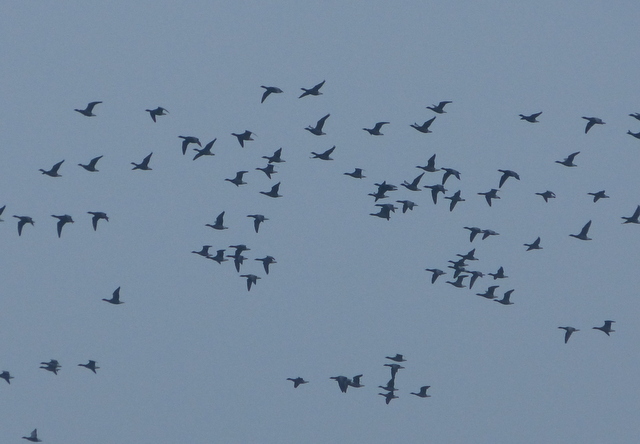 Brent Geese – flying inland to feed early in the morning
Brent Geese – flying inland to feed early in the morning
At our first stop, it didn’t look promising, as there was no sign as we pulled up of any of the usual Little Owls – they were obviously not enjoying in the cold either. We spent some time admiring the group of feeding Curlew in the nearby stubble field and several Brown Hares running around (but not boxing today). A big flock of about 600 Brent Geese came up from the direction of the coast and flew overhead cackling noisily, heading to the winter wheat fields inland to feed. Just when it appeared as if the Little Owls would not appear today, a little ball of fluff appeared tucked down in the lee of the roof. Unfortunately, it was quite close to us and nervous and dropped down again too quickly to get everyone onto it. Still, at least it was a start.
We moved on, stopping to admire a group of House Sparrows in a hedge. In amongst them were a couple of slightly smaller birds, with uniform chestnut caps and paler white cheeks, with a black spot in the middle – two Tree Sparrows. This species has been declining at an alarming rate, so it is always good to see some clinging on here. Amongst the group there was also a rather House Sparrow-like bird with a distinct but poorly marked black spot on its cheek, presumably a House x Tree Sparrow hybrid. As this little group of Tree Sparrows has declined, perhaps the lack of available partners has increased the risk of hybridisation?
As we continued westwards, a large flock of thrushes flew up from a stubble field into the hedge. We stopped and watched them as they flew back out to feed – mostly Fieldfares but amongst them also a few Redwings. These winter visitors presumably waiting for milder weather to begin the journey back to Scandinavia. Also in the field, a flock of smaller Linnets whirled round several times but disappeared every time they landed.
One of our favourite morning stops in recent weeks has been to scan some inland wet grazing meadows. A Red Kite was perched in one of its regular trees and circled off lazily as we got out of the car. Lots of Fieldfares were out on the grass and we got great views of these ones through the scope – amongst them was a single Mistle Thrush. We also got a better look at a flock of Linnets, but there was no sound of the Little Owls here today.
 Little Owl – perched up in one of its favourite places again
Little Owl – perched up in one of its favourite places again
It was still not especially warm, though at least the drizzle had stopped. We checked out another couple of Little Owl sites and, just as we were about to give up hope, we found one. It was perched up in one of its favourite places, sheltered but facing the sun (or where the sun should be!). We had a good look at it from the car, with it looking round furtively all the time, then parked behind the hedge a little further up and got out quietly. This is normally a very quiet spot, but just at that moment the local postman arrived to empty the postbox – what were the chances of coinciding with that today! The Little Owl took one look at all the activity and dropped quietly into the barn. Still, we had all fortunately got a good look at it before it did so.
From there, we headed up to the coast for the middle hours of the day. There were surprisingly few Pink-footed Geese at Holkham today, none on the fields at Lady Anne’s Drive and just a small group heading high west on the beach side of the pines. It is that time of the year when the geese are starting to head north again, and perhaps spring is on its way. Still, there was a nice selection of waders, including Snipe, Redshank, Black-tailed Godwit and Curlew, on the wet grazing meadows. There were also plenty of ducks – lots of Wigeon, Teal, the odd Shoveler, and amongst them a smart group of Pintail by one of the pools.
 Eurasian Teal – a particularly smart drake at Holkham
Eurasian Teal – a particularly smart drake at Holkham
As usual, there were also several raptors over the marshes. Plenty of Marsh Harriers, a few Common Buzzards and a Red Kite drifting towards the park. Salts Hole held its usual Little Grebes and two female Goldeneye, all diving constantly. A quick look at the sea produced a large raft of Common Scoter, though we didn’t have time to go out for a closer look through them today.
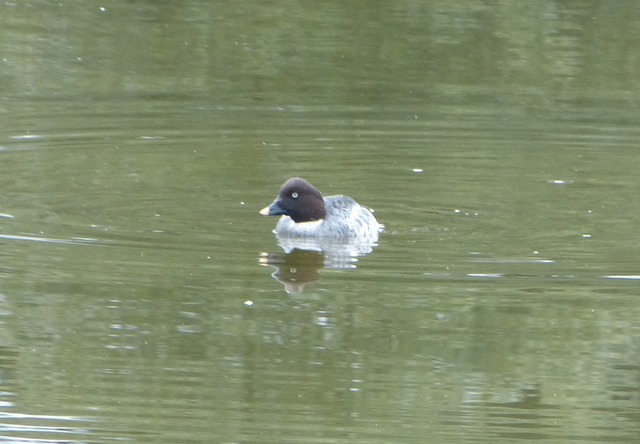 Goldeneye – two females were on Salts Hole today
Goldeneye – two females were on Salts Hole today
One of the highlights of the walk at Holkham at this time of year is always spending time looking at the tit flocks. Today was no exception, and we found several groups of tits – Long-tailed, Coal, Great and Blue Tits – together with their regular hangers-on, Goldcrests and Treecreepers. The latter in particular are always a delight. Some of the birds were coming down to bathe in the puddles along the track again. While we were watching one of these groups, a slightly shriller call alerted us to the presence of something different amongst the flock. Careful scanning of the trees eventually revealed its owner – a stunning, stripy-headed Firecrest. It flicked around in front of us in an ivy-clad pine for a while, before chasing off through the trees with the rest of the flock.
Early afternoon is the time we head over to Burnham Overy. On the way, a quick stop produced an early Barn Owl out quartering the grass. We left behind the crowds standing by the road, and headed out across the marshes. We finally managed to get some better views of geese here – there were several Pink-footed Geese still present, though again not in the bigger numbers we have seen recently, and some lovely gaggles of Brent Geese. The tide was out and the saltmarsh mud held a good variety of waders – lots of Dunlin, several smart Grey Plover, Oystercatchers, Black-tailed Godwits, Redshank and Curlew.
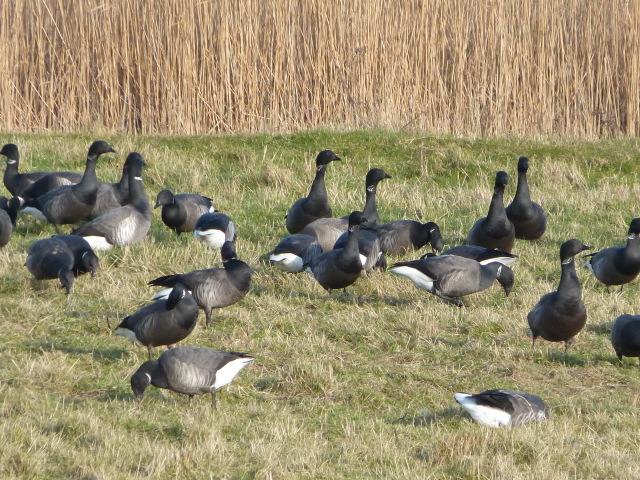 Brent Geese – a noisy gaggle on the grazing marshes
Brent Geese – a noisy gaggle on the grazing marshes
One or two Rough-legged Buzzards have been resident here for the winter, and we saw both today. In the afternoons, they frequently sit around on the fence posts or on the ground, but today they were more active. We picked up the first, flying away from us distantly and perched on a tall mound. As we walked out along the seawall, the second was out in the grass, but showing much better, closer to the bank. We watched it hopping around and flashing its white tail base. The first Rough-legged Buzzard then flew over the grazing marshes and up into the dunes, pausing for a distinctive bought of hovering for a while on its way there. Over the next hour or so, we had great views of the two birds flying round and sitting on the favoured fence posts!
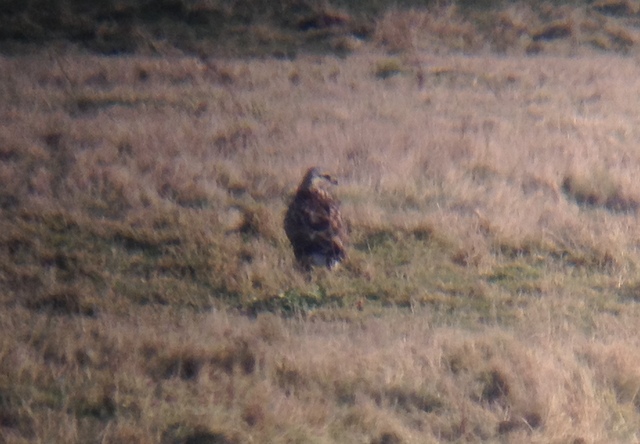
 Rough-legged Buzzard – out on the grass and flashing its white tail base
Rough-legged Buzzard – out on the grass and flashing its white tail base
There has been some flashes of sunshine on the way out – it had been forecast to brighten up in the afternoon – but as we got out onto the seawall we could see some thick mist blowing in off the sea and round the end of the pines. Cold and damp, it felt like it might be curtains for any chance of seeing more owls. However, a brief brighter interlude stimulated a Short-eared Owl to start hunting. It was a bit more distant than we have become used to seeing them (we have been rather spoilt in recent weeks), but we could watch its distinctive stiff wingbeats, and flashing white underwings, as it quartered back and forth. Then another wave of mist rolled in and it disappeared into the grass again.
 Kestrel – hunting from a post, and attracting some (un)wanted attention!
Kestrel – hunting from a post, and attracting some (un)wanted attention!
There were plenty of raptors to see here as usual. The highlight during a sunnier period was a little kettle of five Marsh Harriers and a single Common Buzzard circling overhead. Two of the Marsh Harriers peeled off, calling and even gave us a brief bout of display. A Sparrowhawk perched up on a fence and a Kestrel hunted from a post by the path.
We had almost given up on the owls, and were biding some time taking photographs of the Kestrel, when suddenly a second Short-eared Owl appeared from nowhere right by us and swooped down and started to mob the very Kestrel we were watching. That was much more like it! We watched this one hunting over the grazing marshes, much closer than the first. It was not as active as the Short-eared Owls usually are, perhaps given the cold and damp, and it dropped down into the grass back behind us. We walked back along the seawall and found it still there and had stunning scope views of it, looking round all the time, vivid yellow irises staring at us, and its short ‘ear’ tufts fluttering up at times. Such a smart bird.

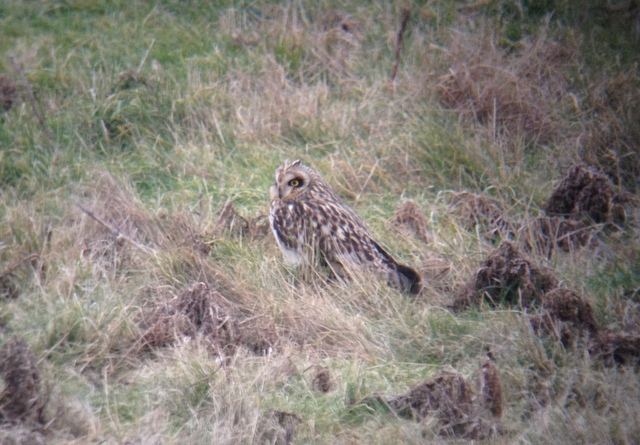 Short-eared Owl – more stunning views eventually today
Short-eared Owl – more stunning views eventually today
In the end we had to tear ourselves away from it. The mist had probably put off the Barn Owls as well – most of us did not see any of the usual birds hunting here, though one member of the party who had struggled with the cold and damp and had walked back earlier did have great views of one from the path, while it was a bit brighter. Still, it felt a worthwhile trade off, given the views of Short-eared Owls we had enjoyed out on the seawall.
With the light fading, we drove inland to one of our favoured spots for Tawny Owls. It was dusk by the time we got there, and they were already hooting even as we got out of the car. We positioned ourselves at one of the best viewing spots and waited. There was lots of vocal activity around us, and not just the cacophony of the local Pheasants heading in to roost! We could hear at least four Tawny Owls either side of us, a mixture of hooting and the sharper ‘kewick’ contact calls (the combination of which is thought to have given rise to the familiar twit-twoo refrain). A real owl experience!
While we were enjoying the noise, yet another Tawny Owl started hooting just behind us and a large shape suddenly appeared through the tops of the trees and came right overhead. It landed directly in front of us, perched up in the bare branches against the sky, and we even got it in the scope! It then dropped back into the trees, resuming its hooting as it flew, before reappearing a few moments later and flying back right overhead and back whence it came. What a cracking way to end.
















